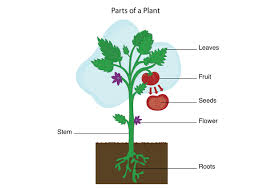MULTIPLE CHOICE QUESTIONS AND FILL IN BLANKS OF STRUCTURE OF PLANTS PARTS
1. Casparian strips are present in
(a) Cortex (b) Epidermis (c) Stele (d) Endodermis
2. The outer most part of the stele consists of one or more layers of parenchymatous cells. The outer layer of this parenchyma is called:
(a) Cortex (b) Epidermis ‘ (c) Stele (d) pericycle
3. The type of arrangement in which protoxylem lies towards the outside and metaxylem lies towards the inside is called:
(a) Mesarch (b) Endarch (c) exarch (d) None
4. The case in which xylem is present towards the inner side and phloem is present towards the outer side of vascular bundle is:
(a) Collateral (b) Bicollateral (c) Concentric (d) Blare])
5. The case in which one type of vascular tissue (xylem or phloem) completely surround the other type of tissue is:
(a) Collateral (b) Bicollateral (c) Concentric (d) Diarch
6. Endodermis is present in:
(a) Monocot (b) Dicot (c) Gymnosperm (d) None4
7. Cambium is absent in:
(a) Monocot (b) Dicot (c) Gymnosperm (d) None
8. The leaves in which palisade layer is restricted to the upper side is:
(a) Bifacial (b) Isolateral (c) Centric (d) None
9. The leaves in which palisade is present on both sides of the spongy tissue:
(a) Bifacial (b) lsolateral (c) Centric (d) None
10. Cortex is formed form:
(a) Plerome (b) Dermatogen (c) Periblem (d) None
11. Pith is formed form:
(a) Plerome (b) Dermatogen (c) Periblem (d) None
12. Root cap is present on:
(a) Primary root (b) Secondary (c) Tertiary (d) All
13. One or more layers of cortex below the epidermis become thick wall to form
(a) Exodermis (b) Stele (c) Endodermis (d) Pith
14. Casparian strips have compound:
(a) Cellulose (b) Lignin (b) Subrin (d) Cutin
15. The outer layer of this parenchyma is called:
(a) pericycle (b) Endodermis (c) Stele (d) None
16. A parenchymatous sheet of tissues separates the phloem strands from xylem and it becomes:
(a) Pericycle (b) Endodermis (c) Stele (d) Cambium
17. The cells of root caps in many parts form a constant structure called:
(a) Stele (b) Strip (e) Medulla (d) columella
18. The number of xylem or phloem bundles in monocot is from:
(a) 12 to 20 (b) 15 to 20 (c) 17 to 20 (d) 12 to 30
19. The number of protoxylem or phloem bundles in dicot is from:
(a) 2 to 9 (b) I to 5 (c) 2 to 5 (d) 2 to 8
20. Which is incorrect for monocot root?
(a) The pericycle gives rise to lateral roots. (b) Cambium is absent.
(c) The pith is present.
(d) Secondary growth does not occur
21. Pith is composed of:
(a) Collenchyma (b) Parenchyma (c) Sclerenchyma (d) None
22. Which is correct for dicot root?
(a) Vascular bundles are scattered irregularly in ground tissues.
(b) The vascular bundles are open.
(c) Cambium is absent.
(d) There is no hard bast.
23. Secondary growth includes the formation of secondary vascular tissues and:
(a) periderm (b) Plerume (c) Epidermis (d) Cortex
24. Suberization occurs in:
(a) Cortex (b) Cork (c) Xylem (d) Phloem
25. The walls of epidermal cells of leaves of the xerophytic plants undergo:
(a) Suberization (b) lignification (c) Cutinization (d) None
Answers:
1. (d) 2. (d) 3. (c) 4. (a) 5. (c) 6. (b) 7. (a) 8. (a)
9. (b) 10. (c) 11. (a) 12. (a) 13. (a) 14. (b) 15. (a) 16. (d) 17. (d) 18. (a) 19. (c) 20. (a) 21. (b) 22. (b) 23. (a) 24. (b) 25. (b)
Fill in blanks:
1. The inner most layer of the cortex is distinct and well developed
in primary roots. It is called______
2. A band of suberin develops all around the cell in the middle of the transverse and radial walls. This suberin band is called
________ strip.
3. The outer most part of the stele consists of one or more layers of parenchymatous cells. The outer layer of this parenchyma is
called ________
4. In case _____ xylem is present towards the inner side and phloem is present towards the outer side of vascular bundle.
5. In case_________ , phloem is present on both side of xylem.
6. In case of__________ bundles, on type of vascular tissue (xylem or phloem) completely surround the other type of tissue.
7. Vascular bundles having cambium between xylem and phloem are called _______ type.
8. A narrow strip of meristematic cells is present between the xylem and phloem in the vascular bundles of dicots and gymnosperms. This strip of meristematic cells is called vascular………..
9. The phellogen produces a group of loosely placed cells at certain points. These loosely placed cells are called ____
10. The tissues in which the cells are undifferentiated and capable of division are called ______
11. The meristems present at the tips of roots and shoot are called _____ meristems.
12. The meristem situated at the bases of intemodes is called ______ meristem. •
13. One or More layers of cortex below the epidermis become thick wall to form_______
14. The outer layer of this parenchynfa is called ____
15. Cells of root caps in many parts form a constant structure called…………..
16. The number of xylem or phloem bundles in monocot is 12 to 20.
17. Secondary growth includes the formation of secondary vascular
tissues and ________
18. The walls of epidermal cells of leaves of the xerophytic plantsundergo……………
Answer:
I. endodermis 2. casparian 3 pericycle
4. Collateral 5. Bicollateral 6. Concentric
7. open 8. cambium 9. lenticels
10. meristem 11. apical 12. intercalary
13. exodermis 14. pericycle 15. columella
16. periderm 17. lignification


I am plant science students (Msc) Agronomy
[email protected]
my email.address is ( [email protected])
very informative but………boringgg
very informative